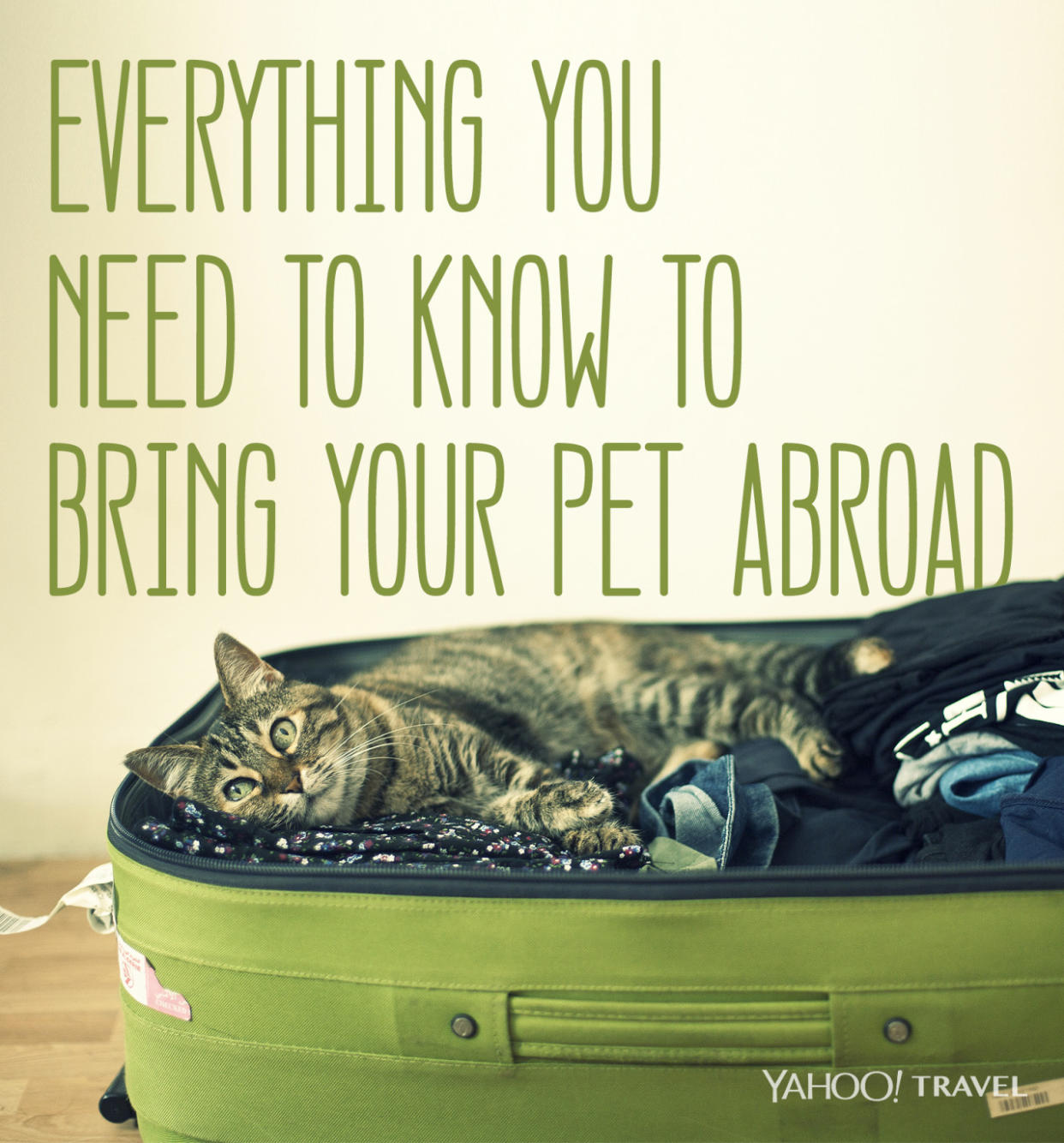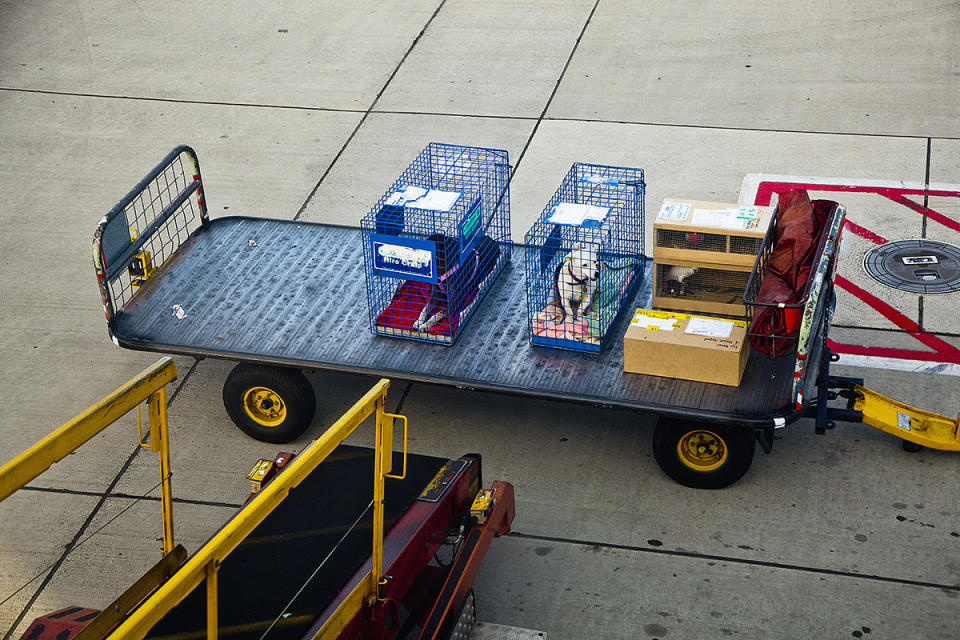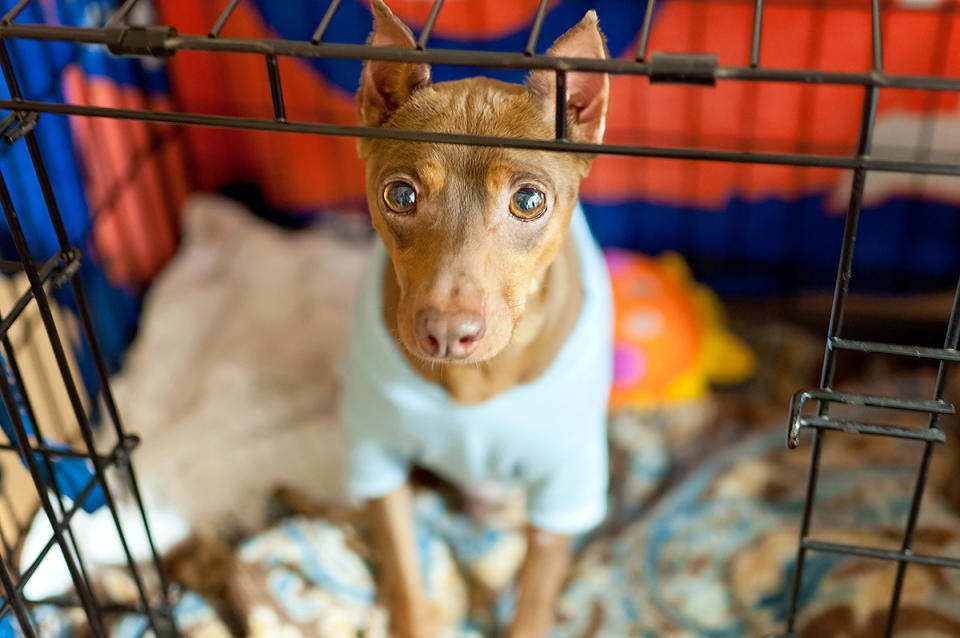Everything You Need to Know to Bring Your Pet Abroad

Photo by Getty Images. Design by Lauren DeLuca for Yahoo Travel.
When I decided to move from New York City to Nairobi, Kenya, my first concern was alleviating the worries of my mother, who was convinced that I would going to come home for Christmas again.
My second worry was what to do about Pete.
Pete (or Peg-Leg Pete, in full) is my three-footed half-witted orange tabby cat, who I adopted three years ago. He had been run over by a forklift in a grocery store warehouse, and when I met him he was a tiny kitten with huge eyes and a big cast on his hind leg; the leg was swathed in a rainbow baby sock. I have a weakness for broken animals, and as soon as I saw him, I knew he was mine. I spent most of that summer carting him back and forth to the vet every day, so his stump leg could be unwrapped, cleaned, checked, and rewrapped. I shelled out hundreds of dollars on an additional surgery to remove the single mangled toenail that remained on his shattered foot so that he could at least put a little bit of weight on the stump when it healed. I spent the months after that cleaning the wound four times each day, removing the gauze and scrubbing the surgical site with iodine while Pete buried his head in my armpit, and then re-wrapping his leg and sliding on a new baby sock. He healed right up, and is a spry, ridiculous, leapy little creature.
In exchange for my fixing his foot, Pete has become a companion so affectionate and loyal I sometimes wonder if it borders on mental illness. He is constitutionally incapable of being more than a few feet away from me at all times. When I’m in the shower, he sits on the sink and peeks his head behind the curtain. He sleeps either at my feet or curled up as the little spoon. As a freelance writer, I’m home during the day, and Pete lounges next to me on the couch or piles onto my lap when I’m sitting at my table. When I get up to go to the bathroom, the neurotic little cat follows.
Related: This Baby Panda is the Best Reason to Visit Washington D.C.
And so leaving Pete in New York for the next few years, even with a trusted cat-loving friend, wasn’t something I was willing to consider. How hard could it be, I reasoned, to get a cat to Kenya? People take their pets places all the time, and he’s a small, portable indoor animal with no current health issues (at least not physical ones).
It turns out getting a cat to Kenya is both hard and expensive. But it would have been a lot less hard and less expensive if the process weren’t so opaque and confusing, and if I hadn’t done nearly everything wrong. Luckily, I learned from my mistakes, and am here to bring you a few tips if you’re trying to get your own Pete across international borders.
1. Plan Ahead.

Bringing your pet abroad is expensive, so start saving now. (Photo: Getty Images)
Getting a pet overseas requires a lot of steps, and they can’t be done in a day (even a week is pushing it). Get going at least a month in advance, more if your travel comes during or just after the December holiday crunch. Getting a pet abroad is also expensive (or at least it can be, especially if the pet has to go in the cargo hold), so set aside some money in advance – think several thousand dollars. Everything is harder the less often people bring their pets to the place you’re going. If you’re traveling from New York to London or Hong Kong, it’ll be pretty simple. If you’re flying to Timbuktu or Ulaanbaatar, you probably have a longer road ahead of you.
2. Pick the Right Flight.
Carefully consider which airlines and routes are good for pets before you buy your ticket. The Amsterdam airport, for example, has a pet hotel in case your animal has to be held overnight, and a relief area where pets can go to the bathroom; if you ship your pet with KLM their cargo areas are climate-controlled to keep animals comfortable, and they have trained folks on the ground in Amsterdam who will make sure the little guy or gal is doing ok. Delta and Lufthansa also have a good reputation for their treatment of animals on flights, and so do a handful of other major airlines. Random airlines or cut-rate carriers may save you some money, but may not have the infrastructure in place to properly handle an animal transfer. It’s worth the extra bucks to ensure that your animal isn’t freezing in the cargo hold or doesn’t get lost by airline workers who treat a pet no better than a large suitcase.
If your pet has to be transported in the cargo hold and you have a layover, make sure the layover is long enough for airline employees to transfer the animal (this usually means at least four hours). It may also be the case that airlines will only transfer animals between flights on the same airline, and not codeshares. I made this mistake when I booked my flight through Delta, and it turned out I was on a codeshare flight operated by Delta from New York to Amsterdam, and then a codeshare flight operated by KLM from Amsterdam to Nairobi. KLM would only transfer the animal from a KLM-operated flight to another KLM-operated flight; that meant Pete had to fly separately from me, and because there was only a three-hour layover between his KLM-operated flight from JFK and the next KLM-operated flight to Nairobi, Pete had to stay overnight in Amsterdam, and it took him an extra day to arrive. That might have been avoided if I had booked a consistent operator with a long enough layover in the first place.
3. Do your research.

Bringing a pet abroad is complicated, so proper research is essential. (Photo: Studio Firma/Stocksy)
Check the Embassy website of the country you’re going to and see what it says about importing pets. For some countries, especially those in Western Europe, the information is relatively clear. For many others, it’s contradictory and confusing. If you’re going to a consulate or embassy for a visa, you can ask the officer about pet import rules, but they may not know much either. In any event, if the embassy website lists documents you need to import your animal, consider that the bare minimum, not the final word. Try reaching out to expat communities, including anyone you know, online message boards, and Facebook groups, to get more intel.
4. Call your airline. Then call them again. And probably again.
Some airlines will allow you to bring a small pet in the cabin with you, for a fee (that fee is usually waived if you have a letter from a medical professional certifying that the animal is an emotional support animal, but even having a support animal, as opposed to a disability service animal, isn’t a guarantee the animal can fly with you in the cabin overseas). Whether you can carry your small pet onboard internationally depends on the rules of your destination – Kenya, for example, requires that all animals come in as manifest cargo, and so carrying Pete with me wasn’t an option. But that fact wasn’t communicated to me the first three times I called my airline about bringing him on board. The result was that I was rushing in the final week before my trip to coordinate all the logistics of shipping a cat from New York to Nairobi. The species and breed of your pet also matters – some airlines won’t allow snub-nosed breeds, like Persian cats, bulldogs, or pugs, in the cargo hold, since those animals can easily overheat.
When you call, make sure the airline agent checks the rules of the final destination country. Ask if the pet can come in the cabin or if it has to be checked as cargo. If it has to be checked as cargo, ask the airline if they do that at the check-in desk at the airport, or if you have to go through the cargo department (with Delta/KLM, the airline I flew, I had to go through the cargo department – of course, no one told me that until soon before I was scheduled to depart). And if they tell you to go through the cargo department, prepare for more phone calls with people who don’t know the answers to your questions and will probably give you bad information. Understand too that some cargo departments will refuse to coordinate with you directly, requiring instead that you go through a third-party animal shipping service. Short version: Hopefully you have a cellphone plan with unlimited minutes, because you are going to spent a lot of time on the phone.
5. Ask (and Pay) the Experts.

If you’re shipping your pet, it pays to get expert guidance. (Photo: Getty Images)
The process of getting an animal abroad can be so strange and difficult that there’s an entire industry dedicated to it. Pet import and export services exist at many major airport hubs and, for an exorbitant fee, these companies can arrange all of your import and export needs. You can find them by googling, or by calling the cargo department of your airline and asking whom they recommend (getting recommendations from your specific airline will often get you better-priced companies that have a direct connection to the cargo department – a big plus). Animal import/export pricing is tiered depending on what you need, so if you can take care of some of the steps yourself that will cut costs. Companies also differ in pricing by a few hundred dollars for similar services, so it’s worth calling around and getting several quotes.
But be careful about taking on too much yourself. Doing bits and pieces on your own can be easy-ish if you’re bringing your pet to a place where a lot of people bring their pets – major European cities, even, I’m told, places like Dubai – but gets more difficult if you’re bringing an animal to a place where pet importation from the United States is less common (Nairobi, as it turns out). The benefit of pet shipping companies is that they can figure out the rules for just about anywhere, and can tackle every step of this convoluted process for you – you just hand over your pet and then pick them up on the other side (some companies will even come to your house). But it comes at a cost of at least $1,100 and some change for the most basic service for a small animal – basically, buying your cat a plane ticket and putting him on the flight – and rises steadily from there, easily pushing $10,000 for a complicated transfer of a large animal. In between those extremes, pet shipping companies can take care of a variety of interim steps, including getting the necessary importation documents and the health certifications your pet will need to leave the country.
Stock up on peanut butter and crackers, because that’s what you’ll be eating for a while as you funnel thousands upon thousands to paying a stranger to get your animal overseas.
6. Find a Guy on the Ground.
Some countries simply don’t give the U.S. government full information about their requirements for pet importation – hi Kenya! – and so you’re flying a little blind. If you go through a pet export company, they find someone local who understands the system to work it for you, and to arrange pickup when your pet arrives. If you’re doing that part yourself, though, you need a reliable importer. If you don’t know anyone in-country and have few contacts there, suck it up and pay the export company to arrange it for you. I found my importer via a Nairobi expat group on Facebook, and ended up paying him about $500 to arrange the import permits and get the cat out of cargo at the airport. Those costs vary widely depending on what country you’re flying into, and will surely be more if you have a middle-man, like a pet shipping company, arrange them – but having someone else arrange them is easier, and is a more sure bet that your guy on the ground is legit.
7. Call Your Vet.

Call your vet to get the required Certificate of Health in order to travel. (Photo: BonninStudio/Stocksy)
Most countries you travel to with a pet will require that you have an up-to-date health certificate for import. This is again something that your export company can do for you if you’re willing to pay for it; I did it myself. You need to bring the pet to a USDA-certified vet within a specified number of days of travel (for Kenya, it was 10) and get a signed Certificate of Health certifying that your animal is in tip-top shape. There are a few common rules: The pet must be up-to-date on rabies vaccines; it can’t be a young kitten or puppy; it must be microchipped. Get a full copy of your pet’s medical records, and especially its rabies certification, from your regular vet and bring that to the fancier USDA-certified vet. The fancy vet will issue the Certificate of Health, which you’ll probably need for an import permit.
8. Jump Through the Government Hoops.
So you have the Certificate of Health from a USDA-certified vet. That should be enough to prove that your pet is healthy enough to fly, right? Wrong! You have to get the actual USDA to stamp the Certificate of Health (and charge you for the privilege). You can mail the certificate, along with the other relevant documents listed on the USDA website, to its headquarters for stamping, or you can go to an outpost. There’s one near JFK Airport in New York City, open from the convenient hours of 8:30am to 11:30am Monday through Friday (and another hour and a half four afternoons a week). During the busy holiday times, they sometimes only serve a limited number of people, so get there early, take a number, and wait for a disgruntled government employee in a state-issued khaki shirt to stamp your document. (This is another thing export companies can do for you, again at a price).
9. Get All the Stuff.

Make sure to get the right kind of crate so your pet can travel safely. (Photo: Getty Images)
To go abroad, your pet needs stuff – and if it’s flying as cargo, it needs very specific stuff that you can’t get wrong. Some of this stuff, particularly an airline-friendly crate, can be surprisingly hard to find in pet stores. Pet export services can again arrange this for you, or you can ask them for the specific crate model and size they recommend and order it yourself – just give it a week or more for delivery, and a few days for your animal to get used to it. It’s also worth getting a small bed to put inside the crate, food and water containers, a few small toys, Live Animal stickers to affix outside of it, labels with your name and contract information to stick on the crate, and a small bag of food along with feeding instructions if the animal is flying for more than a few hours.
10. Get Your Import Permit.
This is one of the most important things either your pet export company or your Guy On The Ground does for you – shortly before your travel date, he sends you (or your pet exporter) the certified import permit, which allows your animal to enter the country. If you don’t have the import permit, your pet travel is a no-go. In some countries you can probably secure this yourself through the embassy, but in others it can be a substantial challenge, and it’s probably worth just paying someone to do it for you.
11. Take Names and Numbers.
Before you depart, get exact instructions, including contact information for everyone you’re dealing with: Where to drop the animal, whether he’ll be held in a heated space until it’s time to board and during the layover, who will be in charge of watching him, when and where exactly you pick him up at the destination airport. Write down names and phone numbers –if you’re traveling to a developing country in particular, many people may not use data on their phones to check email nearly as often as they will answer a call. Make a copies of all the relevant documents – the USDA-stamped Certificate of Health, the import permit, the rabies vaccination – and keep two copies with you, and affix one to the animal’s crate.
12. Drink some of the bad free wine on the flight.
You’ve earned it, and it’s free, so it’s the only indulgence you can afford right now. Then go collect your (thoroughly upset but don’t worry, only temporarily traumatized) creature and bring him to your new home.
Let Yahoo Travel inspire you every day. Hang out with us on Facebook, Twitter, Instagram, and Pinterest.

